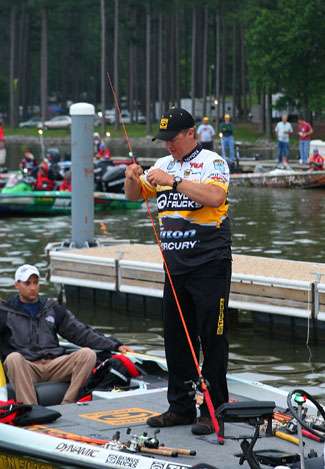
LAKE GUNTERSVILLE, Ala. — Shad courtship is a rough-and-tumble affair, bereft of the niceties of courtship and sworn affection.
At Lake Guntersville, the threadfin shad spawn is a typical wham-bam event. In late April or early May, boy shad and girl shad meet and mingle in the backwater coves and creeks. At some point, when the rising water temperature has reached a suitable level and the eggs within the females have correspondingly ripened, the gals release oily pheromones into the water that tell the lads they're ready to get hitched.
Then they go at it, with the females spewing eggs along a warm shoreline and the males doing their part to make sure the eggs get fertilized. And that's it. The spawn lasts for a few weeks, and each day it generally occurs randomly here and there in the first hour or so after daybreak. And the bass love it, or at least they love to eat big mouthfuls of shad while they're all bunched up.
It's the shad spawn that is keeping most of the anglers afloat in the Southern Challenge. As the semifinal round began with anglers leaving the dock Saturday at Lake Guntersville State Park, boat after boat bore the same sort of tackle on their decks: baitcasting rods and reels festooned with clunky cowbell spinnerbaits and crankbaits bearing the requisite black spot behind the head that mimics the markings of a threadfin.
If there's anything that has the bass so worked up this week on the Tennessee River impoundment, if there's any single factor that has caused the phenomenal fishing that the Elite Series anglers have enjoyed, it's those little threadfin shad.
Though there's no secret about it, the shad spawn has shaped strategies this week and is reshaping tactics Saturday. Some fishermen are following the same daily routine of starting out early, but some are reversing their patterns, hoping to make something happen that will propel them into Sunday's championship round of 12.
"I've fished the shad spawn every morning this week and it's been good to me. But today I'm going to do it backwards," said Terry Scroggins, currently in 27th place with 46 pounds. "I've been getting my bigger fish out deeper in the afternoon, and that's where I'm going to start. I've caught a 6-pounder every day, but I need more of them than just one. I need 28 or 30 pounds to reach the top 12, so I'm going to start where the bigger bass are."
Likewise, Gerald Swindle, who reached the semis with no room to spare, is at the point of giving up on the shallow shad bite, but plans to hit a few coves on the way to what he hopes will be his glory hole.
"I've got to have at least 28 pounds today or I'm going home for sure," Swindle said before this morning's takeoff. "I can catch a quick limit early, but I'm going to spend a lot more time fishing deep-cranking a riprap shoreline. I hit it Friday afternoon and culled three fish real quick. So that's what kept me in, and maybe it will keep me in today."
Twenty-eight pounds isn't that much of a reach. The bass, as Alton Jones described it, are lying on the bottom and pointing upstream with their mouths open. If something goes by, they'll grab it. As crazy good as the fishing is now, everybody knows he can catch a good limit, though a 20-pound stringer isn't going to buy an angler much time chatting up the crowd with emcee Keith Alan on the weigh-in stand. If you can't bust at least a 25-pound haul, don't bother getting dressed up for the party.
Unless you're Aaron Martens, Mike McClelland or Todd Faircloth, of course. The top three leaders don't plan many changes in their routines, though conditions beyond their control, such as a rising wind, might force their hands.
"I've got some ideas about what to do if my fish have left, but there's no reason to think that that's going to happen," said Martens, who has 58 pounds, 14 ounces. "I fished shallow on Monday in practice and caught 25 pounds or so. I don't know if anybody else has hit those fish, but I don't think so. So I'm feeling comfortable with my tournament."
Though Martens, McClelland and Faircloth are atop the leaderboard now, they can't afford any slip-ups. They have to fish perfectly, because a stalking horse named Rick Clunn is plodding along behind them, and he's made a career out of breaking the hearts of aspiring younger anglers. Clunn, who's been fighting the flu all week, has been fishing for about three hours a day and then resting. Even so, he's in sixth place with 51 pounds, 14 ounces and has bass galore. Ditto for Mike Iaconelli, who's in fifth place with 54 pounds, 10 ounces.
If either Clunn or Iaconelli boat a big kicker, they're moving up. In an odd sort of way, that's the story of the Southern Challenge. Catching lots of bass is not the problem, even catching 6- and 7-pound bass is a cinch. It's that toad or two, the big ones that draw a collective whew of appreciation from the weigh-in crowd, that's going to put somebody over the hump.
And if that lunker is hooked while gorging on threadfin shad, even better. The little guys have already done their part to make the Southern Challenge memorable.
